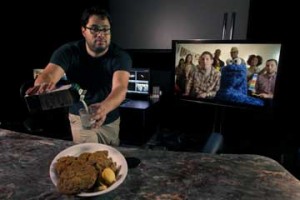
Blackmagic Design announced yesterday DaVinci Resolve 9 was used by New York City-based colorist and online editor Juan Salvo for finishing and color correcting the wildly popular Cookie Monster music video spoof of the Carly Rae Jepsen song “Call Me Maybe.”
Directed by Josh and Jason Diamond of the Diamond Brothers and produced by Jim Muscarella for New York-based production company The Hidden Fortress, the spoof was created to support an already popular tweet from Sesame Street and quickly became one of the most popular viral videos in the U.S. In order to capitalize on the popularity of the tweet and the viral nature of social media, the project needed to be completed within a couple of days, and Resolve 9’s acceleration of the overall color correction workflow were essential to meeting the incredibly tight deadline.
Working out of GRS Systems, a rental, production and post house in New York City, Salvo used Resolve 9’s new features, including streamlined project selection, scrubbable media thumbnails to speed up source clip review and shot selection and production metadata fields for shot notes, naming of nodes and resizable gallery stills. And with all the grading controls on new, larger palettes, Salvo had faster access to the tools he needed.
“With Resolve 9’s new streamlined project workflow, I was able to conform the locked cut of Cookie Monster’s ‘Share It Maybe’ in seconds,” said Juan. “And great new organizational features like node labeling, markers and pins allowed me to keep track of exactly what I was doing and what I needed to do to realize my clients’ vision.”
In homage to Jepsen, one scene shows the original music video playing on a computer monitor. During production, the music video was played on an LCD screen, but the images were not clear in the resulting footage. Salvo used Resolve 9 to track the computer screen as it moved in the shot. Additionally, he was able to qualify and exclude the performers in the foreground. By combining the two techniques using Resolve’s node-based workflow, Salvo was able to make drastic adjustments to correct the issues in the shot and save the cost and time of a VFX pass that would have required tracking, rotoscoping and compositing.





